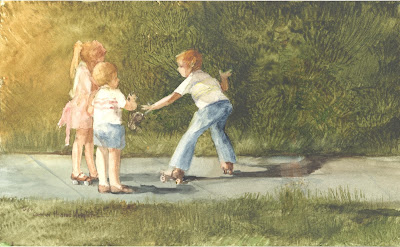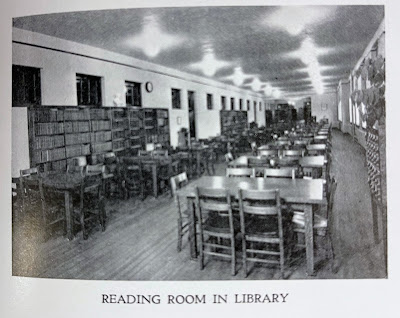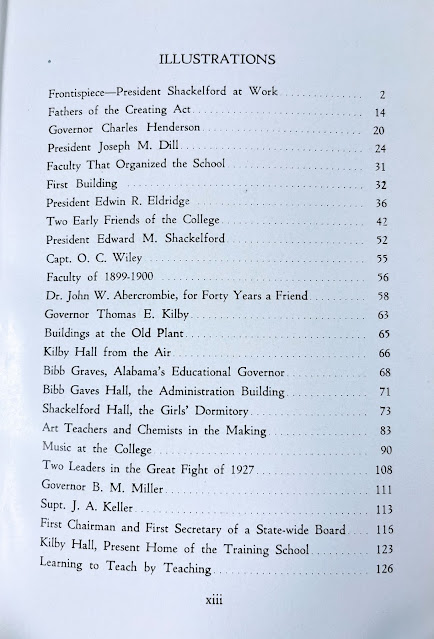Mary Lafayette Robbins opens her introduction by noting that "The making of this book has been a labor of love." Her goal is to make known the achievements of Alabama women in intellectual development, specifically literature. By page two her agenda is clear, however. She is critical of the whole "new woman" concept then current in America that promoted the idea women could move beyond their "proper environment." Robbins then promotes the idea that literary clubs and literature are good fits for the "capacities and limitations of woman."
Thursday, March 23, 2023
Alabama Book: Women in Literature in 1895
Thursday, March 16, 2023
The Great Hartselle Bank Robbery of 1926
I've written about Hartselle in a previous post and covered a few of its historical highlights. Famed author William Bradford Huie was a native and is buried there. Other notable figures include John Sparkman, a U.S. congressman, senator and vice-presidential candidate in 1952, and Steve Woodward, who spent seven years as a Major League baseball pitcher.
Hartselle is also famous for an event that took place in the town on March 15, 1926--perhaps the most spectacular bank robbery in state history. Let's investigate.
Just after midnight on that Monday morning as many as eight men appeared in town and headed for the telephone exchange. There they cut three cables that tied Hartselle to the rest of the world via telephone and telegraph. Then they proceeded to the Bank of Hartselle. Along the way the gang kidnapped several locals who were awake at that hour and tied them up in the back of the bank. These men included J.B. Huie, the train station agent; Oscar Williams, who was waiting for a train; Les Williams, the police officer on duty, and Ernest Mittlwede, cashier of another bank heading home from a date.
The robbers used six sticks of dynamite to open the safe, and after four hours left town with more than $14,000 in cash, gold and silver. No one was ever arrested for the crime. In its article about the robbery, the Decatur Daily reported the presence of two "high-powered" cars in Hartselle on Saturday, one driven by a woman and the other containing two men. Around 6 a.m. Monday Birmingham police found an abandoned vehicle containing empty money bags and numerous checks. The car had been stolen Sunday night from a city resident.
Hartselle had a population of just over 2000 in 1926. Blogger Michele Jackson has written that authorities at the time in other small towns noted similarities between this robbery and one in Center, Alabama, on April 7 and another in Tennessee on April 10. Hartselle itself has kept memory of the crime alive; a reenactment took place in 2019. An historical marker can be seen at the end of this post; the building that housed the bank still stands and was a boutique called Bella Reese as of 2015.
The article below appeared in the Tuscaloosa News on March 15, 1926. A 2020 article by Jackson can be read here. See also an Associated Press story, "Shocking, unsolved 1926 bank robbery still provokes interest" that appeared in the Birmingham News on March 18, 2000.
According to the 1920 census via Ancestry.com, William Bradford Huie's father was John B. Huie. That census gives John's occupation as telephone operator for the railroad.
Source: Hartselle Enquirer
Thursday, March 9, 2023
Carolyn Shores Wright, 1929-2023
I've done several posts on this blog about my mother Carolyn Shores Wright and her activities. One item covered her high school modeling stint for Avondale Mills. Her career as a professional artist, mostly in watercolor, lasted almost fifty years. I've written about the time she heard George Washington Carver speak in Camp Hill when she was seven years old. I've also covered the 1950 Auburn football game my parents attended soon after their wedding, and a bit about the Jefferson County town where she was born, Powhatan.
Mom died on January 17, so I wanted to do a tribute to her on this blog. I've included the text of her obituary, since it covers the highlights. Also in this post are some photos of her and family and some images of her art to give an idea of the variety of subjects she painted.
More comments are below some of the photos and images.
Carolyn Shores Wright December 28, 1929-January 17, 2023
Carolyn Shores Wright, 93, of Huntsville, AL passed away
peacefully at home Tuesday, January 17. She was born in Powhatan, a west Jefferson
County coal mining town that no longer exists. Carolyn and her siblings were
the children of long-time Methodist
minister John Miller Shores, and they lived in various towns including Camp
Hill, Florence, Sylacauga, Alex City, and Montevallo. One of her vivid memories
from childhood was hearing George Washington Carver speak in Camp Hill when she
was about 7 years old. During high school, Carolyn was a model for Avondale
Mills. She attended college at Montevallo and Auburn, where she met her husband
of 52 years, A.J. The passions of her
adult life were family, her church and her painting. She and A.J. were founding
members of Aldersgate United Methodist Church in Huntsville. For about fifty
years Carolyn was a very prolific artist, first in oils, then acrylics, and
finally “her medium” as she described it, watercolors. During those years she
created hundreds of works that featured hummingbirds and many other birds,
flowers, still lifes, landscapes, people and a series of humorous and whimsical
bird paintings she called “Bird Life.” Carolyn was preceded in death by husband
Amos Jasper Wright, Jr.; her mother Tempe Flowers Shores and father John Miller
Shores; step-mother Edith Shores; sister Hethie Shores Kuehlthau; sister
Marjorie Shores Pike; and brother John Miller Shores, Jr. She is survived by
her sons Amos Jasper Wright III [Dianne] and Richard Ashley Wright [Lucy]; brother
Max Shores [Cindy]; grandchildren Amos Jasper Wright IV [Kim], Ashley T. Wright
[Jessica], Becca Wright; and Miller S. Wright [Kathyrn]; and
great-grandchildren Ann Collins Wright, Ashley McDonald Wright, and Ezra Jasper
Leon. Also surviving are two special nieces Charlotte Shores Ryder [Curtis] and
Cindi Shores Sherrill, as well as many other nieces and nephews. Visitation
will be held Saturday, February 4, at 11 A.M. at Aldersgate United Methodist
Church in Huntsville, with service to follow at noon. Internment will be in
Maple Hill Cemetery in a private family service. In lieu of flowers memorials
to Aldersgate United Methodist Church (Honduran Mission) or the Alabama
Sheriffs Youth Ranches would be appreciated.
Mom and my children, Becca and Amos
Mom with my younger brother Richard and his sons Ashley and Miller. Mom was in her red hair phase; the red hat phase came later.
A formal family portrait in the late 1950's. Mom always wanted me to digitize this photo and take her out; she was not fond of the hairdo.
Yours truly, mom and brother Richard on the steps of our house on Cloverdale Drive in Huntsville in the mid-1950s. The three of us revisited the house in July 2018.
Richard and mom walking toward dad's grave in Maple Hill Cemetery. That spring 2022 visit was the last time we took her there.
Mom said this painting was suggested by her brother John--he would roller skate really fast up to his sisters and turn away just in time...
Thursday, March 2, 2023
The Library at Troy State Teachers College Before 1937
The downsizing of my book collection has accelerated in recent months, and here's another departing tome that's coughed up something interesting.
The book this time is Edward M. Shackelford's The First Fifty Years of the State Teachers College at Troy, Alabama, 1887 to 1937. The volume is a detailed history of that institution up to the year of publication. What caught my attention is the extensive material in the book on the college library. Have worked in Alabama libraries for many years, I'm naturally interested in their history and have posted a number of pieces related to the topic. Some of them--but not all--can be found at Alabama Library History: A List. I really need to update that list...but I digress. I've also attempted a very incomplete chronology of state libraries up to about 1920.
Shackelford wrote this history from experience. He taught at the college for 12 years [1887-1899] and served as President for 37 [1899-1937]. At the time of publication he had been named President Emeritus in 1937. Shackelford Hall, named in his honor, was built in 1930; it's now a coed dorm.
As you can tell from the table of contents below, this book covers a lot of topics in the history of what is now Troy University prior to 1937. Two chapters cover the library. In the first one the author gives an overview based on a report written by Charlotte Smith, librarian at the time of publication. Then her report appears in full in the Appendix.
When Shackelford became President in 1899, the library had some 5000 volumes. By the time this history was written, there were some 16,000 books, 1000 government reports and about 150 magazine subscriptions. The library had been located in several different places, and the current one is shown in the first two photos below. One large room on the second floor of Graves Hall provided a reading and collection area, supplemented by workrooms.
The longer chapter by Charlotte Smith adds many details, including the names of librarians and the various sources of books in the early days. In 1909 an agreement among the Carnegie Foundation, the city of Troy and the college led to the construction of a Carnegie Library to be used by both townspeople and college students. Two librarians spent the summer of that year cataloging the 5000 books before the facility opened. Unfortunately, this relationship between the city and college only lasted a decade, as Smith details.
Shackelford's book is a a rich history of Troy in its first half century. In addition to the narrative, he has included such important lists as faculty by department, school physicians and nurses, librarians, etc. The book includes numerous photographs.














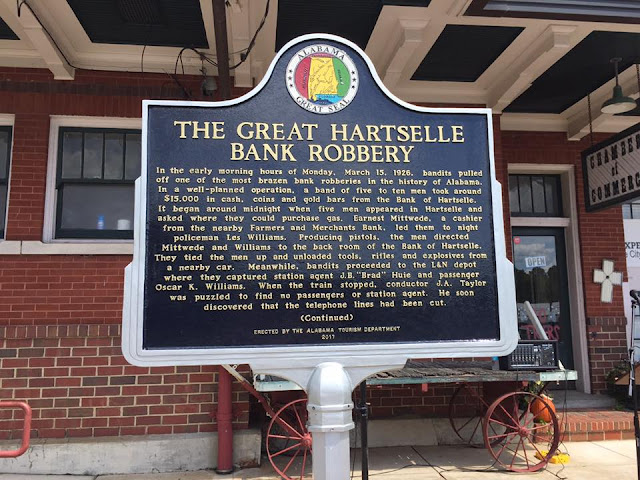




.jpg)
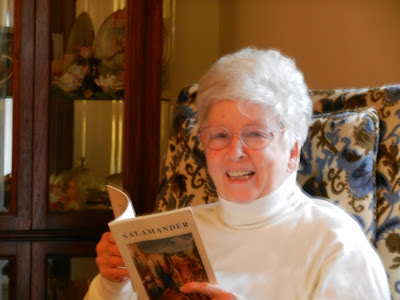
.jpg)

.jpg)


.jpg)
.jpg)






